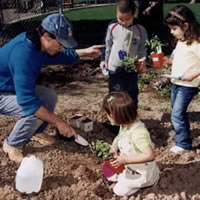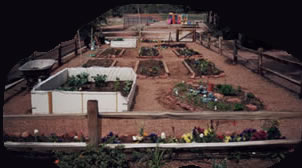MAKING A GARDEN
How do we go about it?
 Gardens come in many shapes and forms depending on site and climate, which determine what kind of earth there is for planting and how much water and sun are available. Gardens may need supplementary soil, compost (made up of sand, leaves or vegetable matter, manure mixed together to decompose) and minerals, lime or bone meal for too acid soil, pine needles for too basic soil. Acidity or base soil can be determined by a litmus paper test; (pink acid, blue base) minerals (potassium, nitrogen, etc.) can be measured and bought.
Gardens come in many shapes and forms depending on site and climate, which determine what kind of earth there is for planting and how much water and sun are available. Gardens may need supplementary soil, compost (made up of sand, leaves or vegetable matter, manure mixed together to decompose) and minerals, lime or bone meal for too acid soil, pine needles for too basic soil. Acidity or base soil can be determined by a litmus paper test; (pink acid, blue base) minerals (potassium, nitrogen, etc.) can be measured and bought.
Here are just a few varieties of garden one might choose from:
- Desert Garden Mostly rocks, gravel, drought resistant plants — cacti, agave, saguaro, etc.
- Water Garden Pond, reeds, thirsty plants
- Butterfly Garden Bright colors, scents, butterfly bush, phlox, etc.
- Berry Garden Raspberries, blueberries, blackberries, etc.
- Fruit Tree Garden Garden Apples, pears, cherries, etc.
- Wildflowers Poppies, lupine, etc.
- Vegetable Garden Beans, peas, lettuces, squashes, etc.
- Shrubbery, Trees and Flowers Most gardens will have mixtures of all.
How to make any of these gardens depends on these steps:
1. Find, lease, or buy a site.
2. Get together an interested group. Design together, or choose an artist designer.
3. Pool enough money for basic tools — shovels, hoes, trowels, mattocks, wheelbarrows — and for seeds, seedlings, plants, or approach garden clubs for help. If additional funds are needed, you can have a bake sale, or flea market.
4. Prepare your soil: turn it up and over, add compost, add whatever minerals it needs and/or fertilizer. Use mattocks or pickaxes if necessary.

5. Buy your plants.
6. Planting: Dig a hole for each plant; then put a little water in the hole. Insert plant, pat earth around it and make a small ring of earth around the plant to hold water in.
7, Label your plants and keep garden records.
8. Water gently each day for first week, less frequently every other day after. Be sure it has enough water, but don’t drown it. Seed-packets usually include directions. Keep watering frequently the entire first year for new shrubs and trees. Afterward, water as needed.
9. Weeds will come soon enough. Weeding between plants is necessary; otherwise, plants can be choked out. You can stack hay or straw between rows in a vegetable garden, or around plants to help keep weeds down. If they are not thorny, you can add weeds to compost heap; they will disintegrate and enrich the heap.
10. Plants should mature, produce fruits, vegetables and seeds in time. Pick as wanted and save seeds of plants you like.
11. After vegetables have been harvested, put all husks, stems, etc. into compost or chip them up. Add compost and manure to whole garden and dig or rototill in. You can plant a winter cover crop, which you’ll rototill in next spring, or leave to mulch over winter.
______________________________________________________________________________________________
GfH HOME • Visionaries: Gardeners of the Spirit • The Earth Is Our Garden • Our Story • Participate • Contact & Resources
© 2008 Gardens for Humanity All rights reserved
